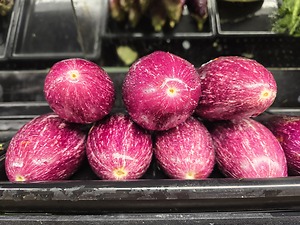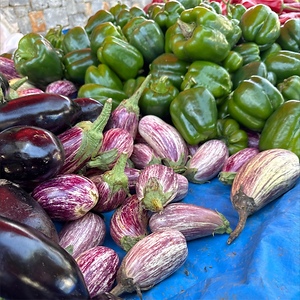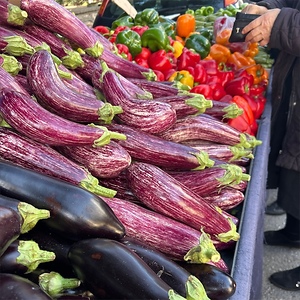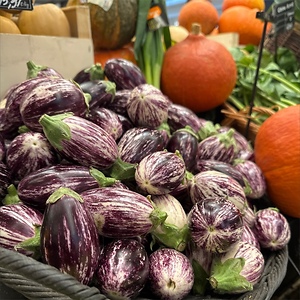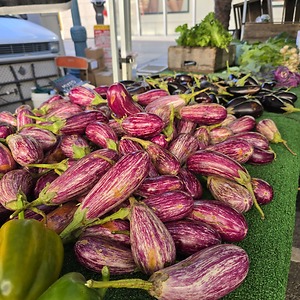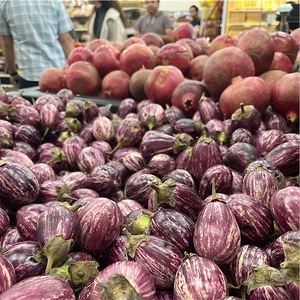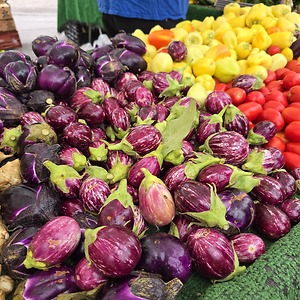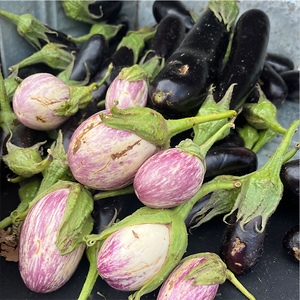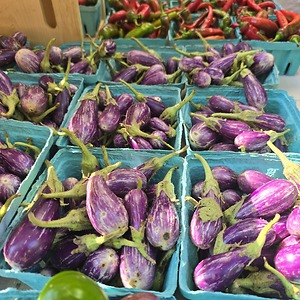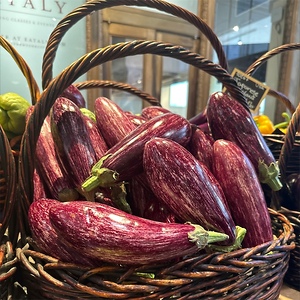

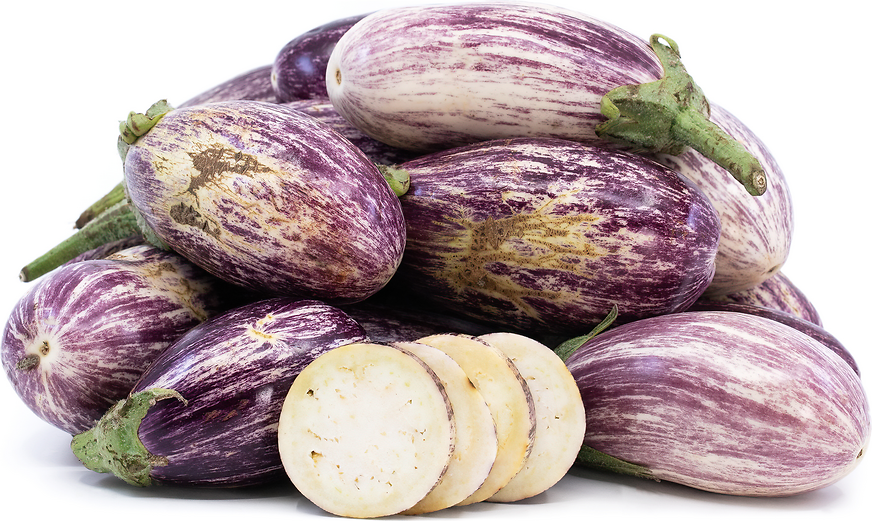
Graffiti Eggplant
Estimated Inventory, 18 lbs : 0
Description/Taste
Graffiti eggplants vary in size and shape, depending on cultivation conditions, but are generally small to medium in size, averaging 7 to 15 centimeters in length. The eggplants have an oblong, oval, and slightly squat shape with blunt curved ends and are topped with a thick, green stem and leaves that extend down the shoulders. The skin is smooth, thin, taut, glossy, and firm, showcasing variegated and mottled purple-white striping. Underneath the surface, the white flesh is springy, moist, and dense when raw. The flesh oxidizes quickly after exposure to the air and is filled with tiny cream-colored seeds. Once cooked, the flesh softens into a tender, succulent, and melting consistency. Graffiti eggplants are edible after cooking and should feel heavy for their size without visible blemishes or wrinkling. Select eggplants that are firm but have a slight give when gently squeezed. Graffiti eggplants are known for their sweeter flavors and also bear a light, sweet aroma when sliced. The variety must be cooked and has a sweet and slightly fruity flavor without the bitterness commonly found in other cultivars.
Seasons/Availability
Graffiti eggplants are available year-round, with a peak season from summer through early fall when grown outdoors. Graffiti eggplants are also planted in greenhouses, extending their presence in markets throughout the year.
Current Facts
Graffiti eggplants, botanically classified as Solanum melongena, are a category of multiple varieties with a purple and white striped appearance belonging to the Solanaceae or nightshade family. There are many different types of purple and white-striped eggplants grown worldwide, and each variety varies in appearance and flavor, depending on cultivation conditions and genetics. Graffiti is a general blanket term often used for these varieties in English. Graffiti eggplants are also sometimes called Zebra eggplants, Striped eggplants, and Sicilian eggplants. The variegated eggplants are known for their prominent striping; a characteristic said to resemble the fluid strokes used in street art. Purple and white striped eggplants are known for their sweeter, less bitter taste and firmer flesh. The varieties are versatile in cooked culinary dishes and have a mild flavor easily adaptable to most cuisines. In the modern day, Graffiti eggplants are a specialty type often seen through fresh markets worldwide. Consumers value the eggplant’s distinct appearance, sweet taste, and easy-to-use nature.
Nutritional Value
Graffiti eggplants have not been extensively studied for their nutritional properties. Eggplants, in general, are a source of fiber to help the digestive tract, potassium to replenish electrolytes and balance fluid levels within the body, and iron to develop the protein hemoglobin for oxygen transport through the bloodstream. Eggplants also provide vitamins C, B, and K to strengthen the immune system, aid in faster wound healing, and contribute energy to daily bodily operations. Other nutrients in eggplants include magnesium, thiamine, copper, niacin, folate, and manganese.
Applications
Graffiti eggplants and other purple and white striped varieties have a sweeter, less bitter taste suited for cooked culinary preparations. Eggplants cannot be eaten raw and must be cooked. The variety has thin skin that can be left intact during cooking, and the flesh is firm, absorbing less oil in dishes than other types. It is important to note that Graffiti eggplants lose their distinct striping with the cooking process and develop a muted purple-grey coloring. The variety is treated similarly to other purple eggplants in recipes and is popularly prepared into dips in the Mediterranean, like baba ganoush and muttabal. These dips are often flavored with lemon juice, aromatics, spices, and tahini and are served with flatbread or crackers. Eggplants are also cooked into various relishes, chutneys, and jams. For overall use, Graffiti eggplants are versatile and can be sauteed, grilled, stewed, roasted, baked, or pan-fried. In Asia, striped varieties are added to soups, curries, and stews, sauteed over rice with other vegetables, or tossed into stir-fries. In Italy, eggplants are incorporated into pizza and pasta dishes, breaded and fried, or layered and baked with mozzarella and parmesan in a tomato-based sauce in the famous eggplant parmesan. Striped eggplants are also prepared in caponata, a well-known, hearty staple dish served in Sicily, which includes eggplants, capers, tomatoes, and olives. In France, striped eggplants are often used to make ratatouille, and in Spain, the eggplants are cooked and stuffed with rice, herbs, and meats. In Greece, eggplants are layered into creamy moussaka, baked with tomatoes and feta, or sliced in half, cooked, and served as appetizers with savory sauces and toppings. Graffiti eggplants pair well with aromatics such as shallots, garlic, and onions, red bell peppers, chickpeas, spices such as cumin, basil, parsley, oregano, and zataar, and meats such as lamb, pork, poultry, and beef. Whole, unwashed eggplants will keep for several days to weeks when stored in a bag and placed in the refrigerator’s crisper drawer.
Ethnic/Cultural Info
Striped eggplant varieties are some of the most popular types grown on the island of Sicily in Italy. The purple and white-striped cultivars are favored for their sweeter taste and are prevalently seen stacked in large piles throughout the weekly fresh markets. Eggplants are a seasonal staple in Sicilian cooking, and one of the famous eggplant-centric dishes made on the island is pasta alla Norma. This dish is comprised of penne pasta or rigatoni combined with fried eggplant, ricotta salata, and an herb-filled tomato sauce. Pasta alla Norma acquired its peculiar name after the world-famous Italian opera Norma, created by Sicilian composer Vincenzo Bellini. Legend has it the dish arose from the city of Catania, which was also the birthplace of Bellini. There are multiple versions of this story, but it is said that Vincenzo Bellini tried the pasta dish and described it to others as a “Norma,” a term used for something outstanding. Other versions claim a writer known as Nino Martoglio used “Norma” for the dish and commented, “Chista è na vera Norma!” meaning “This is the real Norma!” He believed the dish was so outstanding that it deserved the same praise as the famous opera. Regardless of the true story, pasta alla Norma spread in popularity throughout Italy and has since become an eggplant-centric dish cooked worldwide.
Geography/History
Graffiti eggplants are believed to have descended from eggplants grown in India and the Mediterranean. Wild eggplants arose from regions of India in ancient times and spread in the early ages to parts of China and Southeast Asia. After expansion in Asia, wild species were selectively bred to create cultivated eggplants with improved culinary characteristics. The earliest known references to eggplants occurred in ancient Sanskrit documents, and cultivation in China was noted in records from the Western Jin Dynasty around the 3rd century CE. Eggplants were later introduced to the Middle East and were spread to Africa and Europe through Arab merchants. Various species were planted in Sicily during the 9th century and eventually expanded in cultivation throughout the Mediterranean. Over time, many eggplant varieties were selectively bred, and purple and white striped types emerged as a favorite eggplant of Europe. It is unknown when selections of the striped eggplant types acquired the name Graffiti. Today, Graffiti eggplant is a broad term used to describe varieties of purple and white striped eggplants widely seen in markets throughout Europe, Asia, Australia, and the Americas.
Recipe Ideas
Recipes that include Graffiti Eggplant. One



